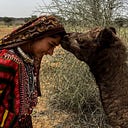Aji-lhamu — the nomadic theatre from Monyul, the land of Monpas
Written by Namrata Tiwari, Narrated by Pema Wange
Dust circles in the air as young children clean the community ground in Tchangpa village of Chug Valley. There is a murmur that Chhampas — the performers have arrived from Kalaktang the night before and will perform the Aji-lhamu dance today. It is a moment of honour and pride for the villagers to host the Chhampas. Gaon Burah (GB), the village headman, has gone to welcome the dance group. Amma Dorjee, the wife of GB, is preparing drinks for the Dunchhang, a feast to be hosted at their home tonight to felicitate the dance group after their performance. Rinchin, Amma’s daughter, pours some Nimak Chai, the butter tea, for us. Sipping the chai, we wait excitedly for the dance to begin in a few hours.
Folk dance, traditional opera or theatre, there are many ways to describe Aji-lhamu. Some believe it is the Tibetan version of the Hindu Epic Ramayana practised by the Monpas of ‘Monyul’ — the land of Mon comprising West Kameng and Tawang districts of Arunachal Pradesh. Aji-lhamu groups reside in every village of the Monyul region. They are taught and mentored by a ‘Lopon’ — a designated teacher. The group travels from one village to another, performing stories and episodes to raise funds for charity work like building bridges, temples, mani and stupas.
Aji-lhamu, which can go up to 7 days in a row, represents a miracle performed by the God-king Ling Gesar Gyepu, who attempted to distract demons from harming humankind. He distracted the demons by narrating a story to them, his five fingers representing characters from the story. The five performers in the Aji-lhamu dance embody Ling Gesar Gyepu’s five fingers. The performers include Nyapa, a fisherman and Nyarok, his assistant, Lhamu and Lham-angying, the two fairy sisters and Jhalu, the king. Nyapa and Nyarok are demons who kidnap Lhamu and Lham-angying when they descend on earth for a purification ritual called Jhaphthrue. Jhalu, the king, comes to their rescue and saves them from the demons — highlighting the conquest of good over evil. The Monpas believe that the Ling Gesar Gyepu reincarnates as the Dalai Lama.
According to another folklore, Aji-lhamu was choreographed 1000 years ago in Mukto village by a Buddhist Lama called Chakzam Wangpo, an architect and a disciple of the first Dalai Lama. He choreographed this dance to entertain people and used the donation money to build bridges between villages that were isolated from each other. The dance, performed during ‘Losar’, is the most significant Monpa festival, which falls between February-March.
Against the backdrop of the valley, adorned in the traditional Monpa attire, Chhampas dance to the reverberating sounds of the cymbals and drums. Ama Dorjee offers us ‘Ara’, a local alcoholic drink. Parallelly, GB is busy preparing for the felicitation ceremony as the performance comes to an end. Ama Dorjee joins GB to felicitate the young group of Chhampas with the Khada — a white ceremonial scarf. Soon the ground clears out as the villagers head for their homes. Ama Dorjee insists we stay back for the Dunchhang. But we have a long day ahead in Nyukmadung the next day and we must start early. We thank Gaon Burah Ji for his hospitality, exchange pleasantries with the Aji-lhamu group and hop onto the car that will take us to our homestay in Dirang.
